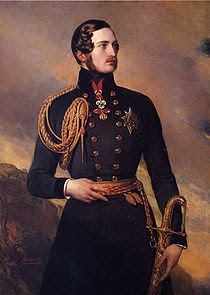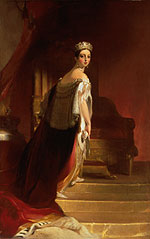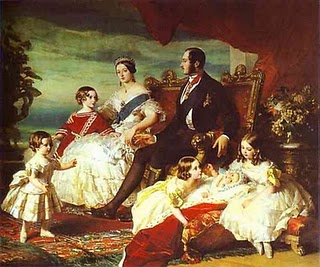Right: Prince Albert by Charles Brocky, 1841
The jewelry, musical compositions, drawings, paintings and furniture exchanged by the royal couple make an interesting statement about the depth of their love and commitment. Many of the items were birthday gifts given to the Prince by the Queen.
 Rupert Friend (right) as Prince Albert in the film The Young Victoria. The costumes and settings were sumptuous, but the story left a bit to be desired by those of us who paid attention to the details!
Rupert Friend (right) as Prince Albert in the film The Young Victoria. The costumes and settings were sumptuous, but the story left a bit to be desired by those of us who paid attention to the details!
 Prince Albert, right, by Winterhalter, in 1842. Albert had an excellent private education. With his older brother Ernest, he was tutored at home and later attended the University of Bonn. He excelled in fencing and riding, and traveled in Italy. Almost from birth, many considered the possibility of uniting the cousins, and King Leopold encouraged the marriage. Victoria and Albert met several times and she was eventually quite taken with him, but after she took the throne at age 18 in 1837, she was in no hurry to wed.
Prince Albert, right, by Winterhalter, in 1842. Albert had an excellent private education. With his older brother Ernest, he was tutored at home and later attended the University of Bonn. He excelled in fencing and riding, and traveled in Italy. Almost from birth, many considered the possibility of uniting the cousins, and King Leopold encouraged the marriage. Victoria and Albert met several times and she was eventually quite taken with him, but after she took the throne at age 18 in 1837, she was in no hurry to wed. After her coronation, however, she wrote to Uncle Leopold: “Albert’s beauty is most striking, and he so amiable and unaffected — in short very fascinating.” Louis Auchincloss in his Persons of Consequence: Queen Victoria and Her Circle (1979) observes: “A principal industry of the German States in the nineteenth century was the production of marriageable princes and princesses.”
After her coronation, however, she wrote to Uncle Leopold: “Albert’s beauty is most striking, and he so amiable and unaffected — in short very fascinating.” Louis Auchincloss in his Persons of Consequence: Queen Victoria and Her Circle (1979) observes: “A principal industry of the German States in the nineteenth century was the production of marriageable princes and princesses.” The wedding took place on February 10, 1840. Albert’s role in the realm was unclear, and it changed, evolving over the next few years until he became very influential and quite popular (though only after his death was his popularity recognized by most in the government). Albert and Victoria became the parents of nine children.
The wedding took place on February 10, 1840. Albert’s role in the realm was unclear, and it changed, evolving over the next few years until he became very influential and quite popular (though only after his death was his popularity recognized by most in the government). Albert and Victoria became the parents of nine children. At right is a family portrait, also by Winterhalter, of the family in 1846.
 One of Albert’s greatest achievements was the Great Exhibition of 1851. As a supporter of science and technology, he was particularly influential upon industrial advancements of the day. In addition, he single-handedly modernized and revamped the running of the royal palaces and the financial administration of the monarchy.
One of Albert’s greatest achievements was the Great Exhibition of 1851. As a supporter of science and technology, he was particularly influential upon industrial advancements of the day. In addition, he single-handedly modernized and revamped the running of the royal palaces and the financial administration of the monarchy. Prince Albert died of typhoid fever at 10:50 p.m. on 14 December 1861 in the Blue Room at Windsor Castle, in the presence of the Queen and five of their nine children, leaving the Queen devastated. Though she lived on until 1901, Victoria never shed her widow’s weeds.



Terrific post- Thanks:) And Happy B-Day to the ultimate Prince.
He really must have been a wonderful man to inspire such devotion. And his dedication to technology and science was a force for change in England that still shows results today.